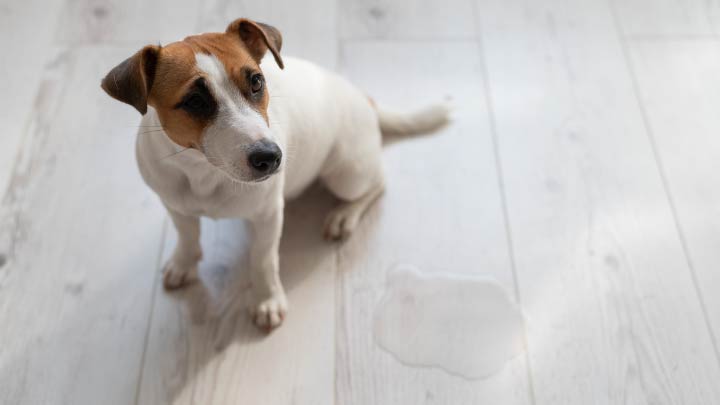
There may be nothing more frustrating and stressing on the bond shared with a pet than to find a freshly laid urine puddle sitting on the kitchen floor. Or a wet spot on the carpet that you really hope is just water, but know it really isn’t.
Inappropriate urination, regardless of cause, puts a strain on relationships with our pets. But while medical causes can at least often have some clear method of treatment, behavioral causes can be much tougher and are a leading reason for relinquishment of pets to shelters.
In this article, we are going to chat a little about medical causes, but we’ll be looking far more closely at the dog who for some reason, leaves those little puddles for you due to a behavioral cause.
Most importantly, we’re going to focus the most on some tips to work on how to correct behavioral causes of inappropriate peeing in the house.
Considering the Medical
We’re keeping things simple in this article by making an assumption. We’re going to assume that our pups in question here are urinating around the house because of a behavioral issue.
But that doesn’t mean of course that there aren’t non-behavioral causes to consider. There are many medical ones, and it’s actually very important to rule these out first.
That’s why, if you notice any changes in your dog’s urinary habits, especially sudden changes, it’s important to get in touch with your vet before making any assumptions yourself.
Running a urine sample and some basic lab work can rule out many common medical causes that lead dogs to lose control of their normal bladder function, like urinary tract infections, kidney disease, diabetes, and others.
And the good thing is that in many cases, there is medical or sometimes even surgical treatment that can address some of these causes. Urinary tract infections can be treated with antibiotics, bladder stones can be treated and prevented with diet or removed surgically, and diabetes can be treated with insulin and diet change.
So it makes sense to rule medical causes like these out first in case there’s an opportunity to clear up or at last manage a medical condition.
But assuming our lab work and other testing looks normal, let’s talk behavior.
Behavioral Causes of Inappropriate Urination
There are two most common time periods in their lives that dogs exhibit inappropriate urinary behavior. The first is when they’re puppies new to a home and figuring it out. The second is during an adolescent-type stage when they start to rebel just a bit against previous training, usually around several months of age.
There are a couple of small exceptions. One example might be a non-neutered or intact male dog exhibiting urinary marking behavior in the home. This might be because the scent of past pets, even from previous homeowners, can still be picked up and he’s trying to cover it with his own.
Another one might be an adult dog recently rescued from a poor situation. A dog who was tied up or kept caged and not socialized well isn’t going to have the best bathroom habits.
This is another reason it’s important to chat with your vet. After ruling out a medical cause, figuring out the root of a behavior requires understanding past history, and analyzing what scenarios a behavior happens in, so that one or more triggers can be discerned.
If we’ve managed to do this, and we can narrow down a dog’s inappropriate urinary behavior to a new unfamiliar environment, poor previous housebreaking, or even just a “rebellious” stage, here’s some tips.
Tip #1: Positivity Rules
In general with any kind of training, a positive approach is the most productive way to see results. While negative reinforcement like shock collars, physical reprimands, and punishment may still be used by very few, there has been a gradual shift over the decades to focus on positive reinforcement with only brief corrections when needed. Why? It’s more effective. The same goes for treating coprophagia in dogs. (stool eating)
The whole idea of being the alpha by exerting physical and verbal dominance over a dog has proven time and again by behaviorists to be ineffective. There is no evidence that negative reinforcement is superior for helping you get your dog to do anything you want. Most of the time you just end up with a scared dog that has been conditioned to be afraid of everything, especially people.
Now, that doesn’t mean that verbal reprimands and conditioning aren’t a part of training, but they are only a small percentage of a training regimen. Positive reinforcement makes your pup happier and helps her learn faster. Focus on what you want your dog to do for you, not what you don’t want her to do.
Here’s an example. Let’s say your pup has a pee accident that you come across. Bringing him over, shoving his face in it, and yelling “bad dog” accomplishes nothing. This is especially true if it’s not a fresh accident but one that occurred much earlier, while you were in another room.
What’s best to do instead is to catch these accidents immediately (you’ll learn more about how to do that with Tip #3!), and if so, you can bark a loud “No!” but make sure to take your pup outside immediately. If she does further business outside, provide a small treat reward and lots of verbal praise to put a positive spin on things.
And to that end, provide a treat reward and lots of verbal praise every time your pup uses the potty outdoors appropriately, at least initially. Over time, you’ll be able to reduce the need for food rewards and rely solely on verbal praise, which you can use life-long and calorie-free.
In this way, your pup will respond much better to you being happy, than being mad. And yes, these accidents can be really frustrating when they happen, especially if you’ve had a long day at work or at home with the kids. But your dog, and especially a young puppy, doesn’t understand that and looks to you for guidance. So make sure to hide that frustration and focus on the positive with your pup.
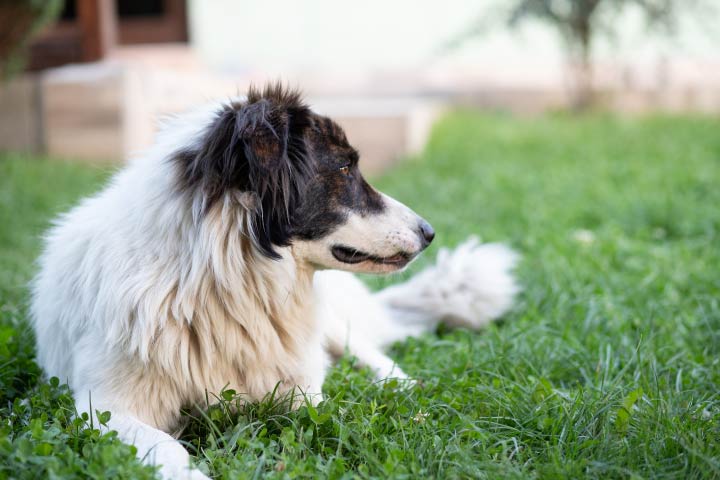
Tip #2: Providing a Safe, Clean Space
An important step to successful potty training (or re-training) is to establish a space where your dog will not have accidents. For puppies only, this can include a small playpen, but for most dogs (and additionally important for puppies) this will be a crate.
By necessity to allow visibility, air flow, and security, a dog crate typically looks like a cage. But the crate should function as anything but. It should be a safe, comfortable space.
Include food and water in your pup’s crate. Dogs rarely urinate or defecate in the same area they eat and drink from, so in addition to providing some of life’s important comforts, keeping the food and water bowls in that space also discourages accidents. Feel free to include toys and bedding too, as long as your pup doesn’t destroy them when left alone.
So that your pooch doesn’t associate the crate or pen with punishment (or with you being absent from the home, fomenting separation anxiety) keep these areas open while you’re home to allow your pooch to enter and exit them as she pleases.
But the most important role the crate or pen fills with potty training is to be where you put your pup when you can’t supervise him, even if it’s just for a minute. Most folks think about crating only if they leave the home, but not so much for quick errands around the house, and that can often be when accidents happen. Even if you have to go to another part of the house where you can’t keep your dog under direction supervision, he needs to be in his crate or pen.
If you have an adult dog who was recently adopted with no previous training, make sure to focus on crate training right away. Since it can be more challenging to teach an “old” dog “new” tricks, seek help from a certified trainer or veterinary behaviorist if you’re not faring well after a couple of weeks.
Sometimes, although a dog was initially crate-trained as a young pup, a human family may lapse on reinforcing crate use. Relaxing training and a structured routine that has worked well in the past, has been known to lead to some behavioral lapses as well.
Think about any changes in environment or routine that might have occurred shortly before pee accidents started. You might find that re-establishing these practices will help.
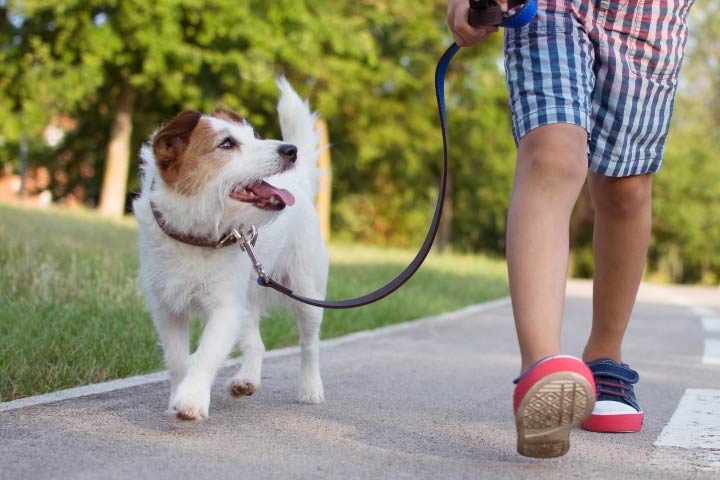
Tip #3: Constant Supervision and Leash Training
I already mentioned that a big part of being successful in potty training is to make sure your pup is constantly supervised. This makes sure that if an accident occurs, you can immediately provide the appropriate correction, redirection, and positive reinforcement if he does further business outside.
This may seem daunting at first, but there’s two ways you can keep your young pup within sight at all times. One is with crate training which we just reviewed, and the other is with in-home leash training. That’s right. You need to keep your pup on a leash with you inside your home.
It’s important to note that this is not the same thing as tying a dog to something with a leash. What we’re talking about here is using an extra long leash tied or attached to you–one that’s long enough to allow your pup to roam freely but short enough that she can’t go into the next room and out of your line of sight. You can hold the leash, wrap it around your wrist, or tie it around your waist, but it has to be on you at all times.
What in-home leash training allows you to do is to make sure your pup can’t have an accident out of your sight, as this allows for immediate correction. Again, barking a “no” combined with a quick pull on the leash is appropriate, but make sure to focus on positive reinforcement with some training treats after taking her outside.
And don’t worry, you will be able to get rid of the leash. It can take several weeks sometimes, but with consistency, and following the rest of the plan, you should find the leash is no longer necessary.
Tip #4: Keep a Log
For those of you with human children who have endured potty training (which I might add takes much longer than with pets) you learn quickly that you need to stick to a schedule and encourage your child to go potty regardless of whether or not they “have” to go.
Similarly, a mistake some new pup parents make is to wait for their pooch to “tell” them she needs to go by whining, scratching at the door, or giving a signal. As human parents all know, waiting until your child realizes he or she needs to go often ends up in a frantic rush to the bathroom and arriving just a little too late.
If you have a new puppy or a newly adopted dog, it can be really helpful to keep a log of all the major necessities your pup engages in, like eating, drinking, playing, and using the bathroom. When you record when these items happen the most, you’ll be able to figure out a schedule for potty times.
In the same vein, if you have a previously well-trained dog who starts having accidents, taking a step back to look at the big picture to see if there’s a pattern to them can help you understand if you can anticipate your pup’s needs and avoid accidents in the first place.
You may find that you need to adjust your own schedule to match your pup’s. For example, you might find that you need to let him out an extra time around your lunch break by zipping home for 10 minutes, because he has an accident as soon as you let him out of his crate when you get home.
Or, when you’re with your pup the whole day and she’s being really active, you might find that you need to let her out more often, even every 30 or 40 minutes, because she’ll have an accident if you stretch that time out to an hour.
Hiring a dog walker to come let your pup out at certain times can also be helpful if you’re stuck at work all day and can’t make it home.
If you find little rhyme, reason, or pattern, and we’re sure a medical cause has been ruled out, you’ll at least know it’s not a timing issue and focusing on training is all the more important.

Tip #5: Monitor Water Intake
A common concern among some pup parents when their dog is having accidents is that maybe their dog is “getting too much water”.
On some occasions I have found this to truly be the case, where a dog simply has a behavioral fascination with water and is in love with drinking it. More water consumption equals more pee. This can especially be the case prior to bedtime and crating for the night.
The technical term for this is called psychogenic polydipsia and is not super well understood. Thus, it’s also a diagnosis of exclusion, meaning we have to rule out other more likely medical causes first.
Although a first instinct when seeing pee accidents in the home might be to restrict water, we have to be super careful with this because it can easily lead to dehydration. I don’t recommend restricting water intake until we determine exactly how much water a dog is taking in and if this is truly an abnormal amount.
Thus, if you’re seeing drinking or pee problems, it can be helpful to first calculate out your dog’s physiological water intake needs and compare that with how much water she’s getting per day.
Sometimes, pet parents will find that what they think is too much water is actually the right amount.
The rule of thumb for water intake for a dog is roughly 1-2 cups of water per 10lb of body weight.
If you know your dog’s weight in pounds, measure out the appropriate number of cups of water and set it aside, making sure to only refill the water bowl from this amount.
If your pup runs through this supply of water and is already looking for more, you might actually have an abnormal amount of water intake on your hands and reducing it may be appropriate, as long as you know you’re meeting the actual daily need.
There are a couple exceptions to this. Dogs with underlying medical causes, like kidney disease or diabetes, will most definitely consume more water than they should seem to need. Restricting water for these dogs is inappropriate and will only lead to dehydration. This is one reason ruling out medical causes is so important.
Dogs with a higher metabolic rate, like puppies and athletes, are also going to consume more water. Pulling up water is okay for a young puppy right after that last potty trip before bed, but when active, they often need to consume more water due to their activity level and you want to make sure it’s available.
Any dog that’s going for more than a couple of short walks per day and especially any that are doing a few miles or more a week, will need to consume water after exercise to replenish losses from exercise. This is especially true during hotter months, so it’s important to keep that in mind.
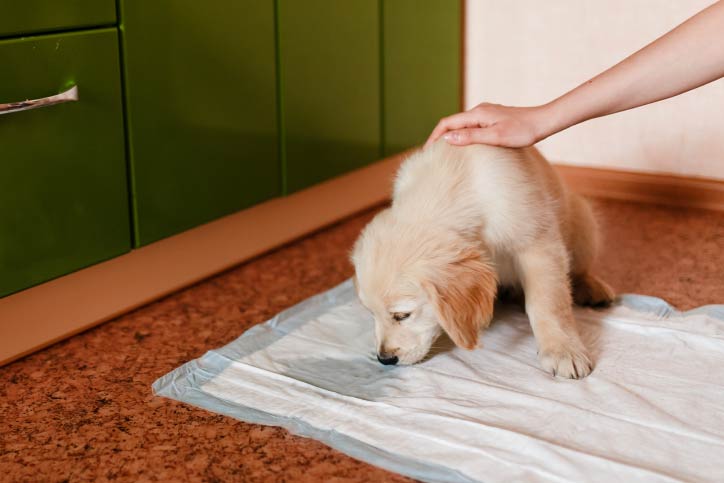
Tip #6: Avoid Using Pee Pads
Some pup parents out there with large breed dogs may be wondering why discussing pee pads is so important, but for you small breed parents out there, you probably get it.
Pee pads (also sometimes called chuck pads) are often used by puppy parents, especially with small and toy breed dogs, either as a segway into actual housebreaking or as a single method of elimination, kind of like a cat using a litter box. Pads are placed in one or more “approved” and “strategic” locations in the home, a pup goes there to do her business, and the pad is thrown away and replaced after a single use.
The main hope with their use as a temporary tool, is that by training a pup to do her business on a pad, this might dissuade her from doing it anywhere else in the house. The idea of training a tiny pup to go outside can be daunting and in an effort to protect a small puppy from the big scary world outside, it seems safer to some to keep their pet indoors.
Unfortunately, we can still see potty training accidents with pee pads in the home and in fact the pads may perpetuate the problem. When little pups start using them reliably, supervision often grows lax and lines get blurred. Dogs that use pee pads, especially with poor supervision, almost inevitably start urinating on similar surfaces, like a throw rug. With no supervision at all, we may graduate from a throw rug to the carpet.
So what almost always happens is that instead of having a puppy that mostly does his business outside and only sometimes has accidents indoors, you now have a puppy who always does his business indoors and inevitably gets confused about where to go. You now find yourself scrambling to get your pooch to go outside, when you’ve already spent weeks teaching him to do it indoors.
Trying to backtrack from pee pads is considerably harder than starting with outdoor training from day one. If you have strong opinions about using pee pads to start, make sure you’re weaning a young puppy off of them by 3-4 months of age. This way, if you find you have serious housebreaking issues at that age, you still have plenty of time to enact the strategies we’re discussing before these habits become permanent.
If you’re bringing a new adult dog into the home who has a poor history or no history of good training previously, avoid the temptation to use pee pads at all.
If you have an older dog suffering from a behavioral issue like cognitive dysfunction (aka doggie dementia), sometimes leading to confusion in his poor mind about where to do his business, you might consider using pee pads in an effort to spare your carpet or floors, since he will be almost impossible to retrain. But keep in mind that once you introduce pee pads, you will probably never be able to go back, and you may find it only helps some of the time.
When “Ur-ine” Over Your Head
Pee accidents in the house are no joke and they can be really frustrating for even the best pet parents.
If you find that some simple techniques haven’t been working, always make sure to get in touch with your vet. As we’ve talked about, some medical causes may need to be ruled out first. If your pup’s doc truly believes a behavioral problem is present, he or she may make a recommendation for a certified in-home trainer or veterinary behaviorist to get involved and help you get back on track.
Getting a behaviorist or trainer involved can be especially important if you are still having housebreaking issues with a dog who is older than 4 months of age or if you’ve just adopted a new rescue pup as an adult and are encountering one or more difficult to correct behavioral issues.
But hopefully, in a majority of behavioral cases, these six tips we just went over will help you and your pup out and help keep that bond between you both strong and happy.
>> Learn How To Treat Coprophagia (stool eating) In Dogs Here
6 Comments
About Us
We've taken the guesswork out of caring for your pets. Our formulations are created by experienced veterinarians to address specific solutions for a variety of pet issues.
All of our products are:
As seen on:








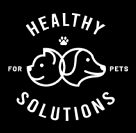



We have four dogs they constantly pee after each other and they’ve all been neutered and spayed they do it outside and in the house and I’m so tired of it they don’t poop they just peed
Hi Patricia,
You could try out Potty Training Spray to help show your pets where to urinate outside!
My rescue pup is 6 months old and still refuses to go potty outside unless I take him out on a leash. He pees and poops on my kitchen. My husband thought pee pads were a good idea for overnight accidents but Harley was using them all the time. I have removed the pee pads, I have cleaned and continue to clean with an enzyme cleaner. I am very frustrated. He’s just stubborn. Any advice?
Hi Sheila,
Our Potty Training spray would be a great start to help direct your puppy to the area where you’d like him to urinate. Here is the link https://healthysolutionsforpets.com/shop/dog-supplements/training-dog-supplements/potty-training-spray-for-puppies-adult-dogs/. Taking your dog out on a leash to the spot where you’d like him to go potty is not a bad idea until he goes there on his own. Frequent potty breaks are recommended if your pup is prone to accidents, both during the day and night. You have to ensure that you set a proper house training schedule for your puppy to learn correctly when it needs to eat, sleep, play, pee and poop. Puppies are quick learners. And positive praise and reinforcement is a must when training!
I have a puppy that is 6 months who pees outside while we are home as long as the back door is open but doesn’t ask to go out. He pees in the night and during the day when we are in work. We have tried everything to stop him doing this but nothing has worked, please give us some advice!
Hi Janette,
You can give our Potty Training spray a try to help show your pup where to urinate outside or inside on a pee pad. With a pup that age, its all about training! Consulting with a dog trainer may be of benefit. If you feel your pup is urinating more than usual inside or out, speak with your veterinarian. Here is a link to our Potty Training Spray https://healthysolutionsforpets.com/shop/dog-supplements/training-dog-supplements/potty-training-spray-for-puppies-adult-dogs/